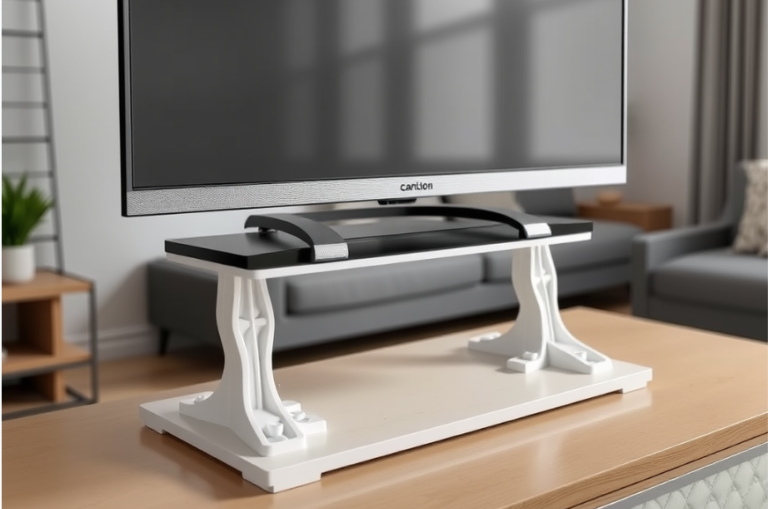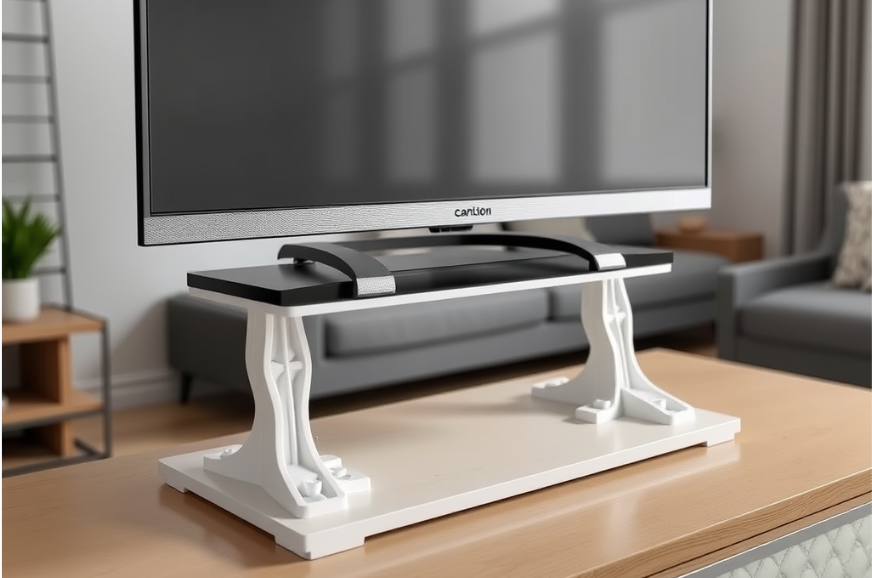
Introduction
In today’s fast-paced world, home design is evolving rapidly, and technology plays a significant role in this transformation. Among the latest innovations, 3d printed Viso TV risers stand out as an essential addition to modern living spaces. These risers not only enhance the aesthetic appeal of your home but also provide functional benefits that cater to today’s needs. With the growing trend of home entertainment setups, many people are looking for practical ways to elevate their TVS for better viewing angles, improved organisation, and optimised sound performance. A 3d-printed Viso TV riser is an excellent answer that lets you keep expenses down and modify the design to meet your particular requirements.

Ideal materials for a TV riser created through 3d 3D-printing
Selecting the correct material guarantees stability and lifetime. These are the best filament choices for a strong TV riser production:
1. PLA, or polylactic acid,
- Advantages include Simple printing, being environmentally friendly, and a smooth finish.
- Cons: Brittle under heavy loads
- Best For: Small, lightweight TVS
2. PETG (Polyethene Terephthalate Glycol)
- Pros: Stronger than PLA, flexible, impact-resistant
- Cons: Requires a heated bed for printing
- Best For: Medium-sized TVs, added durability
3. ABS (Acrylonitrile Butadiene Styrene)
- Pros: Heat-resistant, durable, impact-resistant
- Cons: More prone to warping during printing
- Best For: Heavy TVs, high-temperature environments
4. Carbon Fibre-Infused Filament
- Pros: Extreme strength, premium look
- Cons: Expensive, requires a hardened steel nozzle
- Best For: Large TVs or heavy-duty risers
Designing a 3D-Printed TV Riser
1. Measuring Your TV Base
- Measure the width, depth, and weight of your TV stand.
- Consider space for cables and accessories.
2. Selecting the Right Height
- A height of 3-6 inches works well for most TV setups.
- Higher risers allow for better cable management.
3. Choosing a Sturdy Structure
- Use honeycomb infill for strength without excessive weight.
- Reinforce with sidewalls and thick legs.
4. Adding Non-Slip Features
- Include rubberised feet or TPU pads to prevent slipping.
- Consider ventilation holes to improve airflow.
Why Choose a 3D-Printed TV Riser?
1. Custom fit and design
A 3d-printed TV riser lets you create it with the ideal proportions, height, and shape to fit your entertainment arrangement, unlike off-the-shelf risers.
2. Affordable Substitute
Although commercial TV risers can be costly, especially if you already have a 3D printer, a 3d-printed riser made at home is far more reasonably priced.
3. Enhanced Seeing Experience
An elevated TV improves ergonomics and reduces neck strain, thereby enhancing the comfort of viewing for extended periods.
4. Improve Sound Quality
Many TV stands block speakers designed for downward-firing. Custom risers guarantee correct sound dispersion and airflow.
5. Extra Space for Storage
Keeping your entertainment centre neat and orderly, a raised TV arrangement allows gaming consoles, media players, remotes, and cables room.
Common Issues and Troubleshooting
1. Warping During Printing
- Solution: Use a heated bed and enclosure for materials like ABS.
2. Weak Load-Bearing Capacity
- Solution: Increase the infill percentage and use a stronger filament, such as PETG or carbon fibre.
3. Poor Adhesion Between Parts
- Solution: Use industrial-strength adhesives or design with snap-fit joints.
Printing and Assembly
1. Print Settings for Stability
SettingRecommended Value
Layer Height 0.2mm
Infill 30-50%
Nozzle Size 0.4-0.6mm
Bed Temperature 60-100°C
Print Speed 40-60mm/s
2. Assembling Multi-Part Risers
- If printing in sections, use strong adhesives or screws to assemble.
- Test the weight capacity before placing your TV on top.
3. Post-Processing for Durability
- Sanding rough edges for a smooth finish.
- Sealing with epoxy or primer for a sleek look.
- Painting for customisation.
READ MORE- Does the Unraid Starter License Include Cache Drives?
FAQs:
1. How much weight can a 3d-printed TV riser hold?
It depends on the material and design. PETG and ABS risers with 50% infill can support 30-50 lbs.
2. What software can I use to design a TV riser?
Popular options include Tinkercad (a beginner-friendly option), Fusion 360 (with advanced design features), and Blender (for custom modelling).
3. Can I 3d print a TV riser in multiple pieces?
Yes! If your print bed is small, print in sections and assemble with screws, glue, or interlocking joints.
4. How long does it take to 3D print a TV riser?
Depending on the layer height and print speed, a 12×6-inch medium-sized riser (with 30% infill) takes 10 to 15 hours.
5. Where might I find free STL TV riser files?
For free and premium 3D models, search websites including Thingiverse, Printables, My Mini Factory, and Cults3d.
Conclusion:
Whether your goals are bettering ergonomics, enhancing sound performance, or organising your entertainment area, 3D printing your custom TV riser is a great do-it-yourself project for both techies and home designers. A 3d-printed Viso TV riser is a reasonably priced, adaptable, and helpful tool for upgrading your home entertainment setup. You may build a strong, elegant, and useful TV riser by choosing the correct materials, designing optimally, and applying correct printing procedures.